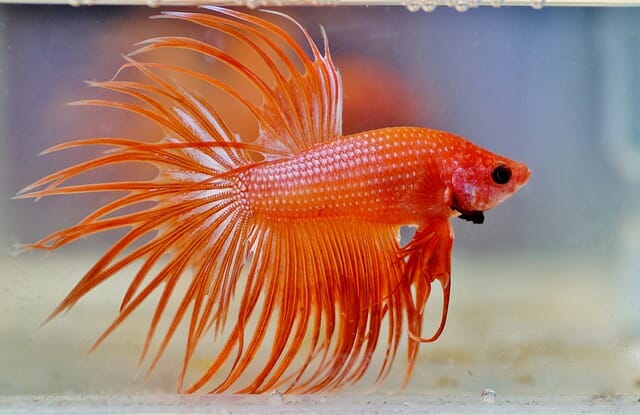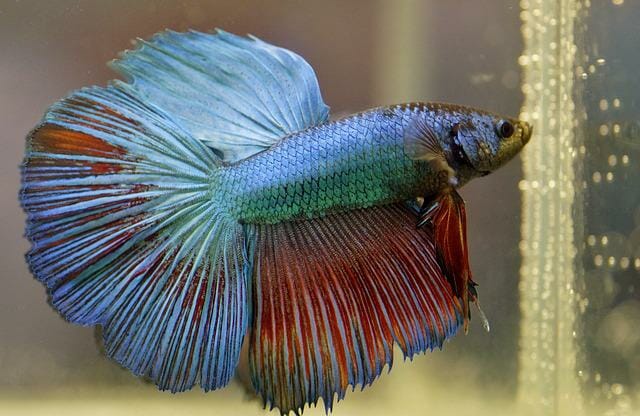How Does Betta Fish Mate: What You Need to Know

Are you looking to add a fun and entertaining fish to your aquarium? If so, betta fish is a great option! These small fish are easy to care for, and they make great companions for other fish in your aquarium.
Betta fish are a popular pet fish known for their bright colors and playful nature. Bettas typically live in pairs but can sometimes be seen living in small groups.
Betta fish mate in a similar way to other tropical fish. The male approaches the female, and they dart around each other before eventually settling into a bubble nest created by the male betta fish. The male then fertilizes the mature female until she lays eggs.
Table of Contents
How to Encourage Betta Fish to Mate?
Choose a Successful Breeding Pair
When choosing a breeding pair of betta fish, there are a few things you need to keep in mind. First, make sure that the fish you are considering are compatible. This means that they both share the same tank and have similar temperaments. Second, look for fish with healthy appetites and bright colors. These indicators of good health will indicate that the pair is likely to produce healthy offspring. Finally, select a well-maintained breeding pair with plenty of room to swim around. This will help ensure your new betta family has plenty of space to grow and multiply.
Provide an Environment for Mating
A breeding tank should be at least 10 gallons and have a sand or gravel substrate. The tank should also have a few plants for cover. The male and female bettas will need a tank with plenty of room to swim and breed. The male betta will territories around these objects, and he will defend them vigorously from other males. He will also display courtship behaviors such as lip-licking and chasing the female around the tank. Once the female is attracted, she will lay eggs on one of his territory objects or bubble nests.
Water Parameters for Mating
There are a few things that you will need to breed betta fish successfully:
- The tank should have water around 75 to 80 degrees Fahrenheit (23 to 26 degrees Celsius).
- The pH level must be around 6.8 to 8.
- The water should have a hardness level of about 5 to 20 dH.
These factors are essential to keep both the male and female betta healthy and happy while mating.
Conditioning the Bettas for Mating
When a betta fish is ready to breed, it will likely become more active and curious. One way to condition your fish for breeding is to provide them with live food items that they usually cannot eat. This will encourage them to become more active and display courtship behaviors. For example, if you have several bettas ready to breed, you can also place them in a small aquarium with plenty of hiding places and cave-like areas where they can lay their eggs.
Introduction of Opposite Betta Genders
Adding the female to the breeding tank is easy. Just remove her from the fishbowl and place her in with the male. Be sure to give them some room to swim around, as they may get excited. Once they are settled in, they can start releasing eggs and watch them hatch into new little bettas!
The first step in introducing the male to the female betta is ensuring that they are healthy and comfortable. When you first bring them home, please give them a small area of their aquarium where they can swim freely. Once they are used to each other, it is time to introduce them. Start by giving the male a small piece of food near the female, and wait for her to nibble on it. Then, slowly raise the male closer and closer until he is swimming right next to her. If she draws closer to him, she indicates that she is interested in mating.
Where the Mating Happens
The bubble nest is an essential part of the reproductive process of betta fish. The male and female fish swim around in circles during courtship, creating a bubble nest. This nest is made up of tiny bubbles that the fish create with their mouths. The purpose of the bubble nest is to protect the eggs from being eaten by other fish or organisms while they are incubating. After fertilization, the male and female fish will expel the eggs from the nest, and they will then hatch into baby betta fish.
What Happens After Mating of Betta Fish?

Egg Hatching & Caring for the Betta Fry
When the betta fish eggs are fertilized, they will hatch in three days. The fry will require care for the first few days, but they should be fine once they have established themselves in their new home. The best way to care for the fry is to provide clean water and a stable environment. You can feed them small bits of food every day, but make sure that they don’t get too fat or they will not be able to swim correctly. Feed them small pieces of fresh organic fish food when they are big enough. If you’re raising your fry, be sure to provide plenty of hiding places so they don’t feel stressed out.